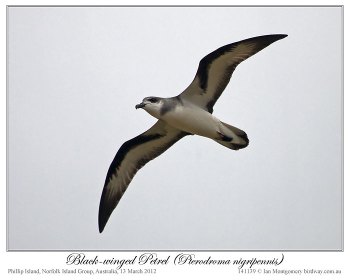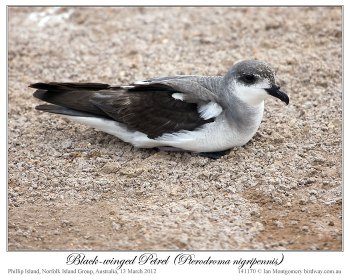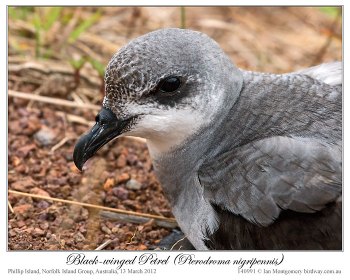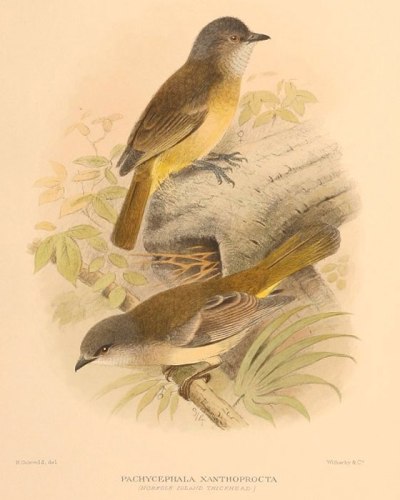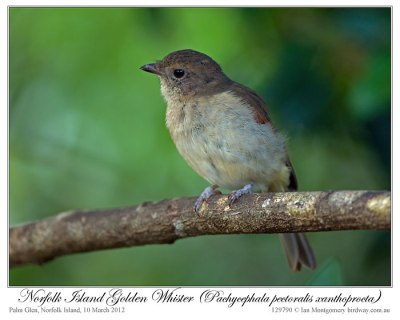Ian’s Bird of the Week – Black-winged Petrel ~ by Ian Montgomery
Newsletter – 5/14/12
Three weeks ago we had the Cape Petrel. Here is the Black-winged Petrel, another species, like the White Tern and Grey Ternlet, that I had seen twenty years ago on Lord Howe Island and was keen to photograph on Norfolk Island. With a length of 28-30cm/11-12in and a wingspan of 67cm/26in, this is quite a small species with elegant black, grey and white markings and a stubby, hooked bill, visible in the first photo.
It nests on both the main island and Phillip Island – where it was quite abundant – and was easy to find as, unlike most petrels and shearwaters, it is active around the breeding colonies in daylight. Most petrels and shearwaters come ashore under cover of darkness to reduce the risk of avian predators such as raptors and gulls, but the Black-winged has historically nested on predator-free islands. ‘Historically’ here means before human settlers introduced predators such as feral cats.
Black-winged Petrels are accomplished fliers and spent much time in aerial acrobatics around and over cliffs. The generic name Pterodroma means ‘winged runner’ and refers to their aerial agility. The one in the second photo is coming in to land near its nesting burrow and passing some Norfolk Island Pines. All petrels and shearwater, except the Giant Petrels, have very weak legs and once on the ground are barely mobile using their wings to drag themselves along on their bellies.
Like many island birds, they seemed unafraid and didn’t appear agitated when approached closely to have their photos taken. The fourth photo shows the tubular nostrils characteristic of this family of birds and their close relatives the albatrosses and storm-petrels. All these ‘tube-nosed’ birds are thought to have a strong sense of smell – very unusual for birds – that helps them find both marine prey and their nesting burrows on dark nights, and the birds themselves apparently have a strong musty odour during the breeding season.
The hooked bill helps the birds grasp slippery prey – mainly squid and small fish – and the bills have sharp cutting edges. The Black-winged is one of about 36 global species of Pterodroma petrels collectively and, I think unfairly, called Gadfly Petrels, in reference to their erratic flight. As I’m sure you know, Gadflies are nasty blood-sucking insects such as Horse and March Flies, and there must be other more congenial erratic fliers after which they could been named. Anyway, Gadfly Petrels feed on the wing by snatching prey from the surface of the water and rarely alight on the water or dive.
The Black-winged Petrel breeds on islands in the south Pacific including Lord Howe, Norfolk, various islands around New Zealand and on several in French Polynesia. Helped by protection and the removal of predators such as feral cats, its population is increasing and it has bred on Lord Howe only since the 1960s. There are unproven recent reports of it breeding on some islands on the east coast of Australia, where it is generally rare. Outside the breeding season, it is highly pelagic and ranges widely over the Pacific as far as southern Japan and Mexico.
Best wishes
Ian
**************************************************
Ian Montgomery, Birdway Pty Ltd,
454 Forestry Road, Bluewater, Qld 4818
Tel 0411 602 737 ian@birdway.com.au
Check the latest website updates:
http://www.birdway.com.au/#updates
**************************************************
Lee’s Addition:
Thanks, Ian, for another interesting Newsletter. Trust you all are enjoying Ian’s Bird of the Week newsletters as well as I do. They are so informative and he introduces us to such a variety of birds. His photograph is outstanding.
The Black-winged Petrel is a member of the Procellariidae – Petrels, Shearwaters Family which has 87 species. They are in the Procellariiformes Order. The order has 3 other families, the Storm Petrels, Diving Petrels and the Albatrosses.
And God said, “…and let birds fly above the earth across the expanse of the heavens.” (Genesis 1:20 ESV)
See Bird of the Week for more articles by Ian.
*
